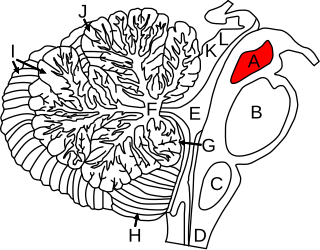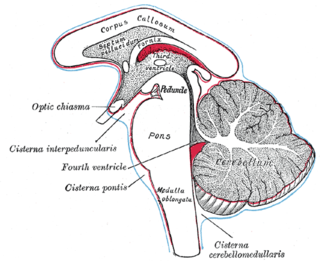Related Research Articles

Public speaking, also called oratory or oration, has traditionally meant speaking in person to a live audience. Today it includes speaking, formally or informally, to an audience through technology – live, pre-recorded, or at a distance.

Weevils are beetles belonging to the superfamily Curculionoidea, known for their elongated snouts. They are usually small–less than 6 mm in length–and herbivorous. Approximately 97,000 species of weevils are known. They belong to several families, with most of them in the family Curculionidae. It also includes bark beetles, which while morphologically dissimilar to other weevils in lacking the distinctive snout, is a subfamily of Curculionidae. Some other beetles, although not closely related, bear the name "weevil", such as the biscuit weevil, which belongs to the family Ptinidae.

The midbrain or mesencephalon is the rostral-most portion of the brainstem connecting the diencephalon and cerebrum with the pons. It consists of the cerebral peduncles, tegmentum, and tectum.

A cistern is a waterproof receptacle for holding liquids, usually water. Cisterns are often built to catch and store rainwater. Cisterns are distinguished from wells by their waterproof linings. Modern cisterns range in capacity from a few litres to thousands of cubic metres, effectively forming covered reservoirs.

The Basilica Cistern, or Cisterna Basilica, is the largest of several hundred ancient cisterns that lie beneath the city of Istanbul, Turkey. The cistern, located 150 metres (490 ft) southwest of the Hagia Sophia on the historical peninsula of Sarayburnu, was built in the 6th century during the reign of Byzantine Emperor Justinian I. Today it is kept with little water, for public access inside the space.

The subarachnoid cisterns are spaces formed by openings in the subarachnoid space, an anatomic space in the meninges of the brain. The space is situated between the two meninges, the arachnoid mater and the pia mater. These cisterns are filled with cerebrospinal fluid (CSF).

The cisterna magna is the largest of the subarachnoid cisterns. It occupies the space created by the angle between the caudal/inferior surface of the cerebellum, and the dorsal/posterior surface of the medulla oblongata. The fourth ventricle communicates with the cistern via the unpaired midline median aperture. It is continuous inferiorly with the subarachnoid space of the spinal canal.

In human anatomy, the left and right posterior communicating arteries are small arteries at the base of the brain that form part of the circle of Willis.

The median portion of the wall of the forebrain consists of a thin lamina, the lamina terminalis, which stretches from the interventricular foramen to the recess at the base of the optic stalk and contains the vascular organ of the lamina terminalis, which regulates the osmotic concentration of the blood. The lamina terminalis is immediately anterior to the tuber cinereum; together they form the pituitary stalk.

Rostrum is a term used in anatomy for a number of phylogenetically unrelated structures in different groups of animals.

The body of the sphenoid bone, more or less cubical in shape, is hollowed out in its interior to form two large cavities, the sphenoidal sinuses, which are separated from each other by a septum.

Psephoderma is a genus of placodonts very similar to the related genera Placochelys and Cyamodus. Psephoderma had a flattened skull and a narrow, straight rostrum, much narrower than that of its relatives. Inside this skull, embedded in the jaws, were rounded teeth specialized for crushing the shellfish it ate. Unlike henodontid placodonts, Psephoderma's carapace was divided into two pieces, one on the shoulders and back, and another on the ventral end. Psephoderma grew to 180 centimetres (5.9 ft) long, larger than many of its relatives, and lived in the Late Triassic, about 210 million years ago. It was one of the last placodonts to live. Fossils of Psephoderma have been found in the Rhaetian deposits in the Alps and in England, hence the specific names.

The pontine cistern is a subarachnoid cistern situated ventrally/anteriorly to the pons. It contains the basilar artery. Each lateral aperture opens into the pontine cistern just posterior to the cranial nerve VIII.

The interpeduncular cistern is the subarachnoid cistern situated between the dorsum sellae (anteriorly) and the two cerebral peduncles of the mesencephalon (midbrain). Its roof is represented by the floor of the third ventricle. Its floor is formed by the arachnoid membrane extending between the temporal lobes of either side. Anteriorly, it extends to the optic chiasm.

Rostrum Records is an American independent record label initially located in Pittsburgh, Pennsylvania, now located in Los Angeles, California. Benjy Grinberg is the founder and president of the label, which currently has sixteen artists on its roster, some of the more notable artists being Mac Miller, Wiz Khalifa, Rich the Kid, Mod Sun, The Bird and the Bee, Donora, Lambo Anlo, TeamMate, Mike Taylor, BRÅVES, Juliann Alexander, and Boaz. Rostrum Records has sold millions of albums and singles, and Rostrum's artists have been nominated for a combined total of eleven Grammy Awards.
The chiasmatic cistern or suprasellar cistern is a small subarachnoid cistern related to the optic chiasm.
The ambient cistern is a bilaterally paired subarachnoid cistern situated at either lateral aspect of the mesencephalon (midbrain). Each ambient cistern has a supratentorial compartment and an infratentorial compartment. Each is continuous anteriorly with the interpeduncular cistern, and posteriorly with the quadrigeminal cistern.

The Theodosius Cistern is one of many ancient cisterns of Constantinople that lie beneath the city of Istanbul, Turkey. The modern entrance is in Piyer Loti Caddesi, Fatih.
The cistern of lamina terminalis is one of the a subarachnoid cisterns. It is situated rostral/anterior to the lamina terminalis and anterior commissure between the two frontal lobes of the cerebrum. It is situated rostral/anterior to the third ventricle. The cistern is an extension of interpeduncular cistern. The cistern of lamina terminalis interconnects the chiasmatic cistern and pericallosal cistern.
References
- 1 2 Hirsch, Martin C. (6 December 2012). Dictionary of Human Neuroanatomy. Springer Science & Business Media. ISBN 9783642571787.